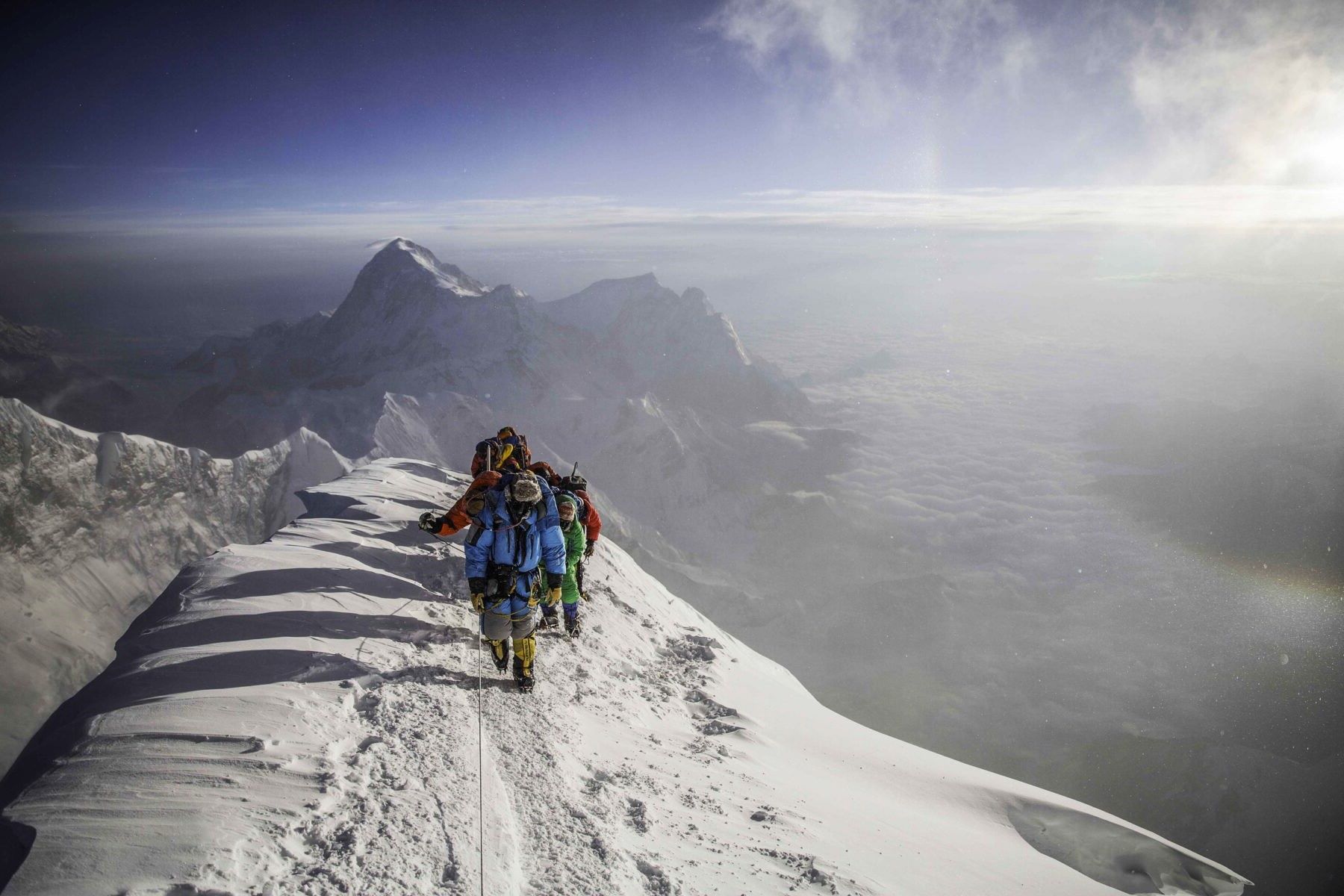Home>Training & Techniques>The Ultimate Guide To Everesting: Everything You Need To Know


Training & Techniques
The Ultimate Guide To Everesting: Everything You Need To Know
Published: February 27, 2024
Discover the best training and techniques for conquering the ultimate challenge of Everesting with our comprehensive guide. Reach the summit of success with expert tips and strategies.
(Many of the links in this article redirect to a specific reviewed product. Your purchase of these products through affiliate links helps to generate commission for Therunningadvisor.com, at no extra cost. Learn more)
Table of Contents
What is Everesting?
Everesting is a unique and grueling endurance challenge that has gained popularity among cyclists and outdoor enthusiasts around the world. The concept is deceptively simple: participants aim to ascend and descend the same hill repeatedly until they reach the cumulative elevation gain of Mount Everest, which is 8,848 meters or 29,029 feet. This monumental feat requires unwavering determination, physical stamina, and mental resilience.
The challenge originated from the mind of George Mallory, a former professional cyclist, who drew inspiration from the ultimate mountaineering achievement of summiting Mount Everest. Mallory envisioned a cycling challenge that would replicate the elevation gain of the world's highest peak. Thus, the concept of Everesting was born, and it has since evolved into a global phenomenon that transcends traditional cycling races and competitions.
To officially complete an Everesting attempt, participants must adhere to specific guidelines set forth by the Hells 500, the organization responsible for verifying and documenting these extraordinary achievements. These guidelines include completing the challenge on a single hill, without using any other descents to accumulate elevation gain. Additionally, participants must track and record their progress using GPS devices or other approved methods to ensure accuracy and transparency.
Everesting is not merely a physical test; it is a mental and emotional journey that pushes individuals to their limits and beyond. The relentless repetition of climbing and descending the same hill can be both physically demanding and mentally taxing. Participants often experience a rollercoaster of emotions, ranging from euphoria to exhaustion, as they strive to conquer the monumental task before them.
The allure of Everesting lies in its ability to transcend the boundaries of traditional athletic pursuits, challenging participants to dig deep within themselves and discover reservoirs of strength and determination they never knew existed. It fosters a sense of camaraderie and community among those who undertake the challenge, creating a shared bond forged through the crucible of endurance and perseverance.
In essence, Everesting represents the epitome of human resilience and the relentless pursuit of extraordinary goals. It embodies the spirit of adventure, determination, and unwavering resolve, inspiring individuals to push beyond their preconceived limitations and reach new heights, both literally and metaphorically.
In the next section, we will delve into the crucial aspect of selecting the right hill for an Everesting attempt, a decision that can significantly impact the overall experience and outcome of this monumental undertaking.
Read more: The Lion Diet: Everything You Need To Know
How to Choose the Right Hill
Selecting the ideal hill is a pivotal decision that can profoundly influence the outcome of an Everesting attempt. The right hill can provide a conducive environment for success, while the wrong choice may lead to unnecessary challenges and setbacks. Here are essential factors to consider when choosing the right hill for an Everesting endeavor:
Gradient and Consistency
The gradient of the hill plays a crucial role in determining the feasibility of an Everesting attempt. A consistent gradient, preferably between 6% and 10%, allows for a sustainable climbing rhythm without excessively taxing the legs on each ascent. Steeper gradients may lead to fatigue and slower progress, while flatter inclines might require additional repetitions to achieve the required elevation gain.
Surface Quality
The surface quality of the hill is another critical consideration. A smooth and well-maintained road or trail can significantly enhance the riding experience, minimizing the impact on equipment and reducing the risk of accidents. Additionally, a predictable surface allows cyclists to focus on maintaining a steady cadence without the distraction of navigating rough terrain.
Accessibility and Safety
Accessibility and safety are paramount when choosing a hill for an Everesting attempt. Select a location with minimal traffic and adequate visibility to ensure the safety of participants. Furthermore, easy access to amenities such as water, restrooms, and shelter can contribute to a more comfortable and efficient experience during the grueling challenge.
Environmental Conditions
Consider the environmental conditions of the chosen hill, including factors such as exposure to sunlight, wind patterns, and potential weather changes. A hill with adequate shade or sheltered areas can provide relief from the elements, while being mindful of wind direction can optimize the descent and conserve energy.
Support Infrastructure
Evaluate the availability of support infrastructure, such as nearby parking, access to emergency services, and proximity to a base camp or support crew. Having a well-equipped support system in place can alleviate logistical concerns and provide reassurance to participants throughout the arduous endeavor.
Personal Connection
Lastly, consider the personal connection and significance of the chosen hill. Selecting a hill with sentimental value or a meaningful backstory can infuse the Everesting experience with added motivation and emotional resonance, fueling determination and resolve during challenging moments.
In essence, choosing the right hill for an Everesting attempt requires a thoughtful assessment of various factors to optimize the overall experience and maximize the likelihood of success. By carefully considering gradient, surface quality, accessibility, environmental conditions, support infrastructure, and personal significance, participants can set the stage for an unforgettable and triumphant Everesting journey.
Training for Everesting
Training for an Everesting challenge demands a comprehensive and disciplined approach to physical conditioning, mental fortitude, and strategic preparation. The monumental task of ascending and descending the same hill repeatedly to achieve the cumulative elevation gain of Mount Everest requires meticulous training tailored to the unique demands of this extraordinary endeavor.
Read more: All You Need To Know About Strava Summit
Endurance and Climbing Training
Central to Everesting preparation is the development of endurance and climbing capabilities. Cyclists embarking on this ambitious journey must prioritize long, sustained efforts to build the necessary aerobic capacity and muscular endurance. Endurance rides, ranging from several hours to full-day excursions, serve as the foundation for conditioning the body to withstand prolonged physical exertion. Additionally, targeted climbing training, including hill repeats and sustained climbs at varying gradients, is essential for acclimating the legs and cardiovascular system to the rigors of ascending thousands of meters over the course of a single ride.
Specificity and Hill Simulation
Given the unique nature of Everesting, training should incorporate specificity to replicate the demands of the actual challenge. This entails identifying hills or segments that closely resemble the chosen Everesting location in terms of gradient and surface conditions. By simulating the intended terrain during training rides, cyclists can familiarize themselves with the nuances of climbing and descending the selected hill, honing their pacing, gear selection, and mental resilience in preparation for the ultimate endeavor.
Mental Resilience and Psychological Preparation
Beyond physical conditioning, training for Everesting encompasses mental resilience and psychological preparation. Endurance athletes undertaking this monumental feat must cultivate a resilient mindset to confront the inevitable mental hurdles encountered during prolonged exertion. Visualization techniques, positive self-talk, and mental imagery of successfully conquering the challenge can fortify mental fortitude and bolster confidence in the face of adversity.
Incremental Progression and Cumulative Fatigue
Training for Everesting necessitates a gradual and progressive approach to adaptation. Cyclists should embrace incremental progression in both distance and elevation gain, gradually increasing the duration and intensity of training rides to simulate the cumulative fatigue experienced during an actual Everesting attempt. By systematically pushing physical boundaries and embracing discomfort within the controlled environment of training, participants can better prepare for the arduous demands of the challenge.
Read more: All You Need To Know About Hamstring Strains
Recovery and Regeneration
Amidst the rigorous training regimen, prioritizing recovery and regeneration is paramount to prevent overtraining and mitigate the risk of injury. Adequate rest, proper nutrition, and cross-training activities such as yoga or strength training can complement the cycling-specific training, fostering overall resilience and reducing the likelihood of burnout or physical strain.
In essence, training for Everesting demands a holistic and methodical approach that encompasses physical conditioning, mental fortitude, and strategic preparation. By integrating endurance and climbing training, specificity and hill simulation, mental resilience, incremental progression, and recovery strategies, cyclists can embark on their Everesting journey with confidence, determination, and a well-prepared body and mind.
Gear and Equipment Needed
The successful completion of an Everesting challenge hinges not only on physical and mental preparedness but also on the selection of appropriate gear and equipment. As participants embark on the monumental task of ascending and descending the same hill repeatedly to achieve the cumulative elevation gain of Mount Everest, the right gear can enhance comfort, performance, and overall safety throughout the arduous endeavor.
Bicycle Selection
Choosing the right bicycle is paramount for an Everesting attempt. Endurance-focused road bikes or lightweight gravel bikes are popular choices due to their balanced blend of efficiency, comfort, and versatility. These bikes offer a responsive yet stable ride, equipped to handle sustained climbs and extended hours in the saddle. Additionally, ensuring proper bike fit and ergonomic adjustments is crucial to minimize discomfort and prevent potential overuse injuries during the prolonged effort.
Climbing Gearing
Optimizing climbing gearing is essential to navigate the relentless ascents characteristic of an Everesting challenge. Cyclists often opt for compact or sub-compact chainring setups paired with wide-range cassettes to facilitate manageable cadence on steep gradients. This gearing configuration enables riders to conserve energy and maintain a sustainable climbing rhythm, mitigating the strain on leg muscles and cardiovascular system throughout the repetitive climbs.
Clothing and Apparel
Selecting appropriate clothing and apparel is vital to ensure comfort and protection during the extended duration of an Everesting attempt. Lightweight and breathable cycling jerseys, padded shorts or bibs, moisture-wicking socks, and well-ventilated cycling shoes contribute to temperature regulation and moisture management, minimizing the risk of chafing and discomfort. Additionally, considering variable weather conditions, cyclists should pack versatile layers, including a lightweight windproof jacket, arm warmers, and a compact rain shell to adapt to changing environmental factors.
Nutrition and Hydration Systems
Effective nutrition and hydration systems are indispensable for sustaining energy levels and preventing dehydration during the rigorous challenge of Everesting. Cyclists often utilize a combination of on-bike nutrition storage, such as top tube bags or saddlebags, to carry energy gels, bars, and electrolyte supplements for convenient access during climbs. Hydration packs or bottles mounted on the bike frame provide continual access to fluids, ensuring consistent hydration throughout the endeavor.
Lighting and Visibility
Given the likelihood of riding during early morning hours, dusk, or even through the night, adequate lighting and visibility equipment are essential for safety and navigation. High-output front and rear lights, as well as reflective elements on clothing and accessories, enhance visibility to other road users and provide illumination during low-light conditions. Additionally, cyclists should consider lightweight and rechargeable lighting options to minimize added weight and ensure prolonged visibility without compromising performance.
Support and Maintenance Tools
Carrying essential support and maintenance tools is imperative to address unforeseen mechanical issues and ensure the continuity of the Everesting attempt. Basic tools such as tire levers, spare tubes, a mini-pump or CO2 inflator, and a multi-tool for on-the-go adjustments enable cyclists to address minor repairs and maintenance without relying on external assistance. Additionally, carrying a mobile phone for communication and navigation, as well as emergency contact information, further enhances preparedness and safety throughout the challenge.
In essence, the selection of gear and equipment for an Everesting attempt plays a pivotal role in optimizing performance, comfort, and safety. By carefully considering bicycle selection, climbing gearing, clothing and apparel, nutrition and hydration systems, lighting and visibility, as well as support and maintenance tools, participants can embark on their Everesting journey equipped with the essential resources to conquer the monumental challenge before them.
Read more: Running And Bunions: What You Need To Know
Nutrition and Hydration Tips
Proper nutrition and hydration are integral components of a successful Everesting endeavor, as the sustained physical exertion and cumulative elevation gain demand meticulous attention to fueling and fluid intake. Cyclists undertaking this monumental challenge must prioritize strategic nutrition and hydration practices to sustain energy levels, optimize performance, and mitigate the risk of dehydration and fatigue.
Pre-Ride Preparation
Before embarking on an Everesting attempt, cyclists should prioritize pre-ride nutrition to adequately fuel their bodies for the demanding physical exertion ahead. Consuming a balanced meal rich in complex carbohydrates, lean proteins, and healthy fats several hours before the ride provides a steady source of energy and promotes glycogen storage in muscles and liver. Additionally, staying adequately hydrated in the hours leading up to the challenge primes the body for optimal performance and endurance.
On-Bike Nutrition Strategy
During the prolonged effort of Everesting, maintaining a consistent intake of carbohydrates, electrolytes, and fluids is essential to sustain energy levels and prevent depletion. Cyclists often rely on a combination of energy gels, chews, bars, and electrolyte-enhanced hydration solutions to replenish glycogen stores and maintain electrolyte balance. Consuming small, frequent portions of easily digestible nutrition at regular intervals helps avoid energy crashes and supports sustained effort throughout the challenge.
Hydration Management
Effective hydration management is critical to offset fluid loss and maintain physiological function during prolonged exertion. Cyclists should adhere to a structured hydration plan, aiming to consume fluids at regular intervals to prevent dehydration. Utilizing hydration packs or strategically placed water bottles on the bike facilitates continual access to fluids, ensuring consistent hydration without disrupting the climbing rhythm. Additionally, incorporating electrolyte supplements in hydration solutions helps replace essential minerals lost through sweat and supports muscular function.
Read more: All You Need To Know About Hip Flexor Strain
Nutritional Variety and Adaptability
Given the extended duration of an Everesting attempt, cyclists should prioritize nutritional variety and adaptability to address changing energy needs and preferences. Incorporating a diverse range of flavors and textures in on-bike nutrition options can prevent taste fatigue and enhance palatability, encouraging consistent intake throughout the challenge. Furthermore, being adaptable to individual nutritional preferences and adjusting intake based on environmental conditions and physical exertion fosters sustained energy and mental acuity.
Post-Ride Recovery
Following the completion of an Everesting attempt, prioritizing post-ride recovery nutrition is crucial to facilitate muscle repair, glycogen replenishment, and overall recovery. Consuming a balanced meal or recovery shake containing a blend of carbohydrates and proteins within the post-ride window supports muscle recovery and replenishes depleted energy stores. Additionally, rehydrating with electrolyte-rich fluids and prioritizing rest and relaxation contribute to the body's recovery and adaptation following the extraordinary physical effort.
In essence, strategic nutrition and hydration practices are fundamental to the success and well-being of cyclists undertaking an Everesting challenge. By emphasizing pre-ride preparation, on-bike nutrition strategy, hydration management, nutritional variety and adaptability, as well as post-ride recovery, participants can optimize their physical resilience and endurance, enhancing their capacity to conquer the monumental task of Everesting.
Mental Preparation for Everesting
Mental preparation for Everesting is a critical aspect that can significantly impact the outcome of this extraordinary endurance challenge. As participants embark on the monumental task of ascending and descending the same hill repeatedly to achieve the cumulative elevation gain of Mount Everest, they must cultivate a resilient and focused mindset to confront the physical and emotional demands inherent in this arduous endeavor.
The mental preparation for Everesting begins long before the actual attempt, encompassing a deliberate and holistic approach to psychological fortitude and emotional resilience. Endurance athletes undertaking this monumental feat must acknowledge the inevitability of mental hurdles and emotional fluctuations throughout the prolonged effort. By embracing a proactive and intentional approach to mental preparation, participants can equip themselves with the tools and strategies necessary to navigate the psychological rigors of Everesting.
Visualization techniques serve as a powerful tool in mental preparation for Everesting. Participants can harness the power of mental imagery to vividly envision themselves conquering the challenge, visualizing each ascent and descent with unwavering determination and resolve. By mentally rehearsing the various stages of the endeavor, cyclists can cultivate a sense of familiarity and confidence, reinforcing their belief in their ability to overcome the physical and mental obstacles that lie ahead.
Positive self-talk and affirmations play a pivotal role in bolstering mental resilience during Everesting. Internal dialogue that emphasizes perseverance, resilience, and unwavering determination can serve as a source of motivation and encouragement during moments of fatigue or doubt. By consciously directing their thoughts and self-talk towards empowerment and positivity, participants can cultivate a resilient mindset that sustains them through the peaks and valleys of the challenge.
Embracing the present moment and adopting a mindfulness practice can enhance mental preparedness for Everesting. By focusing on the sensations of each pedal stroke, the rhythm of breathing, and the surrounding environment, cyclists can anchor themselves in the present, fostering a sense of calm and concentration amidst the physical exertion. Mindfulness techniques can mitigate the impact of mental fatigue and promote a state of flow, enabling participants to sustain their focus and determination throughout the prolonged endeavor.
Furthermore, acknowledging and embracing the emotional spectrum inherent in Everesting is integral to mental preparation. Participants may experience a range of emotions, from exhilaration and euphoria to moments of frustration and fatigue. By accepting the ebb and flow of emotions as a natural part of the journey, cyclists can cultivate emotional resilience and adaptability, allowing them to navigate the peaks and valleys of the challenge with grace and determination.
In essence, mental preparation for Everesting is a multifaceted and intentional process that empowers participants to confront the extraordinary physical and emotional demands of this monumental challenge. By leveraging visualization techniques, positive self-talk, mindfulness practices, and emotional resilience, cyclists can fortify their mental fortitude, fostering a resilient mindset that propels them towards triumph amidst the relentless pursuit of Everesting.
Strategies for Success
Strategizing for success in an Everesting endeavor requires a comprehensive approach that encompasses physical, mental, and tactical considerations. Cyclists undertaking this monumental challenge can optimize their likelihood of triumph by implementing the following strategies:
Pacing and Rhythm
Maintaining a sustainable pacing strategy is paramount to long-term success in Everesting. Cyclists should prioritize a steady and manageable climbing rhythm, avoiding the temptation to start too aggressively. By conserving energy and pacing themselves effectively from the outset, participants can mitigate the risk of premature fatigue and sustain their endurance throughout the grueling challenge.
Efficient Descents
Optimizing the descents plays a crucial role in overall time and energy management during Everesting. Cyclists should focus on refining their descending technique to maximize efficiency and conserve energy. Embracing a balanced approach that blends controlled speed with minimal braking can minimize the physical toll of descents and contribute to overall time savings over the course of the endeavor.
Nutritional Timing
Strategic nutritional timing is essential to sustain energy levels and prevent depletion during the prolonged effort of Everesting. Cyclists should adhere to a structured nutrition plan, consuming small, frequent portions of easily digestible carbohydrates and electrolytes at regular intervals. By proactively fueling the body and replenishing glycogen stores, participants can maintain a consistent energy supply and stave off the risk of bonking or hitting the proverbial wall.
Mental Resilience
Cultivating mental resilience is a cornerstone of success in Everesting. Participants should embrace a resilient mindset that anticipates and confronts the inevitable mental hurdles encountered during the challenge. Leveraging visualization techniques, positive self-talk, and mindfulness practices can fortify mental fortitude, enabling cyclists to navigate moments of doubt and fatigue with unwavering determination.
Read more: All You Need To Know About IT Band Syndrome
Adaptability and Flexibility
Remaining adaptable and flexible in response to changing conditions is key to overcoming the dynamic nature of Everesting. Cyclists should be prepared to adjust their strategies based on environmental factors, physical exertion, and emotional fluctuations. Embracing a mindset of adaptability empowers participants to navigate unforeseen challenges and make informed decisions to optimize their performance.
Support and Encouragement
Drawing strength from a supportive network and fostering a sense of camaraderie can bolster participants throughout the Everesting journey. Whether through the presence of a dedicated support crew, encouraging messages from fellow cyclists, or the camaraderie of the cycling community, cultivating a network of support can provide invaluable motivation and reassurance during the most demanding moments of the challenge.
In essence, implementing strategic approaches to pacing, efficient descents, nutritional timing, mental resilience, adaptability, and support can significantly enhance the prospects of success in an Everesting attempt. By integrating these multifaceted strategies, cyclists can navigate the extraordinary demands of Everesting with resilience, determination, and a well-prepared approach that maximizes their potential for triumph.
Safety Considerations
Safety considerations are paramount in the planning and execution of an Everesting attempt, as the prolonged and demanding nature of the challenge presents inherent risks that must be diligently addressed. Cyclists undertaking this extraordinary endeavor must prioritize safety at every stage, encompassing pre-ride preparations, on-bike practices, and contingency planning to mitigate potential hazards and ensure the well-being of all participants.
Pre-Ride Assessments and Planning
Prior to embarking on an Everesting attempt, thorough pre-ride assessments and planning are essential to establish a foundation of safety. Participants should conduct a comprehensive review of the chosen hill and its surrounding environment, identifying potential hazards such as road conditions, traffic patterns, and environmental factors. Additionally, assessing the accessibility of emergency services, proximity to support infrastructure, and communication protocols contributes to proactive safety planning.
Equipment and Gear Inspection
Ensuring the integrity and functionality of equipment and gear is fundamental to safety during Everesting. Cyclists should conduct meticulous inspections of their bicycles, including brakes, tires, drivetrain, and lighting systems, to verify optimal performance and reliability. Additionally, confirming the adequacy of safety equipment such as helmets, reflective gear, and visibility aids enhances the overall safety preparedness for the challenge.
Traffic Awareness and Visibility
Navigating traffic and enhancing visibility are critical safety considerations during an Everesting attempt, particularly when riding during low-light conditions or through the night. Cyclists should prioritize high-visibility apparel and lighting systems to maximize their presence and alertness to other road users. Additionally, maintaining situational awareness and adhering to traffic regulations contribute to a safe and harmonious interaction with surrounding vehicles and pedestrians.
Hydration and Environmental Monitoring
Monitoring hydration levels and environmental conditions is essential to prevent heat-related illnesses and dehydration during the prolonged effort of Everesting. Participants should prioritize consistent hydration and electrolyte intake, adapting their fluid consumption based on temperature and humidity. Additionally, being mindful of weather forecasts and potential changes in environmental conditions enables cyclists to make informed decisions regarding clothing, pacing, and overall safety.
Emergency Preparedness and Communication
Establishing robust emergency preparedness and communication protocols is indispensable to address unforeseen circumstances and ensure swift assistance if needed. Cyclists should carry essential communication devices such as mobile phones, ensuring access to emergency contacts and location-sharing capabilities. Furthermore, familiarizing support crews with emergency response procedures and coordinating contingency plans fosters a proactive approach to safety and intervention if required.
Support Crew Coordination
For participants supported by a dedicated crew, effective coordination and communication with support personnel are vital to overall safety. Support crews should be well-versed in emergency protocols, first-aid procedures, and navigation of the designated hill to provide seamless assistance if the need arises. Clear communication channels and contingency plans further enhance the safety net for participants throughout the Everesting attempt.
In essence, safety considerations form the bedrock of a successful and responsible Everesting endeavor. By prioritizing pre-ride assessments, equipment inspections, traffic awareness, hydration monitoring, emergency preparedness, and support crew coordination, participants can cultivate a safety-conscious approach that safeguards their well-being and fosters a secure environment for the extraordinary challenge of Everesting.
Recovery and Post-Everesting Care
Recovery and post-Everesting care are integral components of the Everesting journey, representing a crucial phase that directly influences the physical, mental, and emotional well-being of participants following the monumental challenge. As cyclists conclude their extraordinary feat of ascending and descending the same hill repeatedly to achieve the cumulative elevation gain of Mount Everest, prioritizing comprehensive recovery strategies and attentive post-Everesting care is paramount to facilitate optimal healing, adaptation, and overall well-being.
Physical Regeneration
The physical regeneration process following an Everesting attempt encompasses a multifaceted approach aimed at promoting muscular recovery, mitigating fatigue, and addressing potential physical strain. Participants should prioritize rest and relaxation, allowing the body to recuperate from the extraordinary exertion. Incorporating gentle mobility exercises, such as stretching and light movement, can alleviate muscle tightness and promote circulation, facilitating the dissipation of metabolic byproducts accumulated during the prolonged effort.
Nutritional Replenishment
Strategic nutritional replenishment is essential to restore depleted energy stores and support muscle repair following Everesting. Cyclists should prioritize post-ride nutrition, consuming a balanced meal or recovery shake containing a blend of carbohydrates and proteins to initiate the replenishment of glycogen stores and facilitate tissue recovery. Additionally, emphasizing hydration with electrolyte-rich fluids aids in reestablishing fluid balance and supporting physiological function, contributing to overall recovery and well-being.
Mental and Emotional Recovery
The mental and emotional recovery phase post-Everesting encompasses acknowledging and processing the profound physical and psychological exertion experienced during the challenge. Participants should embrace a compassionate and patient approach to their emotional well-being, allowing themselves to reflect on the journey, celebrate their achievements, and acknowledge the resilience demonstrated throughout the endeavor. Engaging in activities that promote relaxation, such as meditation, gentle walks in nature, or engaging with supportive peers, can foster emotional restoration and a sense of fulfillment.
Adaptation and Reflection
Adaptation and reflection play a pivotal role in the post-Everesting phase, as participants assimilate the profound experience into their personal growth and athletic journey. Embracing a mindset of adaptation allows cyclists to honor the physical and mental resilience cultivated during Everesting, recognizing the transformative impact of the challenge on their capabilities and outlook. Reflecting on the lessons learned, the moments of triumph, and the challenges overcome fosters a sense of fulfillment and provides valuable insights for future endeavors.
Professional Support and Monitoring
For participants requiring additional support, seeking professional guidance from healthcare practitioners, such as physical therapists, sports medicine specialists, or mental health professionals, can provide tailored care and monitoring. Professional support facilitates the assessment of physical recovery, the management of potential injuries, and the provision of psychological support, ensuring a comprehensive approach to post-Everesting care that prioritizes the well-being of participants.
In essence, recovery and post-Everesting care represent a pivotal phase that demands deliberate attention and comprehensive strategies to support the physical, mental, and emotional restoration of participants. By prioritizing physical regeneration, nutritional replenishment, mental and emotional recovery, adaptation and reflection, as well as seeking professional support and monitoring, cyclists can navigate the post-Everesting phase with resilience, attentiveness, and a commitment to holistic well-being.
Inspiring Everesting Stories
The realm of Everesting is adorned with awe-inspiring tales of triumph, resilience, and unwavering determination, each narrative encapsulating the extraordinary human spirit and the relentless pursuit of extraordinary goals. These inspiring stories serve as testaments to the indomitable will and unyielding resolve of individuals who have embraced the monumental challenge of Everesting, transcending physical and mental boundaries to achieve remarkable feats.
One such remarkable story unfolds amidst the rugged terrain of the French Alps, where a dedicated cyclist, Sophie Leclerc, embarked on an Everesting attempt that would etch her name into the annals of endurance cycling. Overcoming grueling ascents and unpredictable weather, Sophie persevered through the relentless repetition of climbing and descending, drawing upon her inner strength and unwavering determination. As the sun dipped below the horizon, Sophie reached the cumulative elevation gain of Mount Everest, her triumphant ascent symbolizing the culmination of months of preparation and unwavering resolve.
In the verdant landscapes of New Zealand, another captivating tale unfolds, featuring a group of passionate cyclists who united to conquer the iconic challenge of Everesting. Enduring the rigors of sustained climbing and the camaraderie of shared struggle, this collective of determined individuals exemplified the power of solidarity and mutual support. With each ascent and descent, they forged an unbreakable bond, propelling each other towards the summit of their aspirations and celebrating the collective triumph of their Everesting endeavor.
Amidst the serene beauty of the Italian Dolomites, a solo cyclist, Luca Rossi, undertook a remarkable Everesting quest that transcended physical exertion and delved into the depths of the human spirit. Battling fatigue and moments of doubt, Luca summoned an unwavering resolve that propelled him through the arduous challenge. His solitary journey epitomized the resilience of the human spirit, inspiring countless individuals to embrace their own aspirations and conquer the metaphorical summits that beckon them.
These inspiring Everesting stories, and countless others like them, illuminate the extraordinary capacity of the human spirit to transcend limitations and achieve the extraordinary. They stand as beacons of inspiration, igniting the flames of determination and fortitude in the hearts of individuals who dare to dream and strive for greatness. Each story embodies the essence of Everesting – a testament to the unyielding pursuit of extraordinary goals and the triumph of the human will.
In the next section, we will delve into the crucial aspect of selecting the right hill for an Everesting attempt, a decision that can significantly impact the overall experience and outcome of this monumental undertaking.





